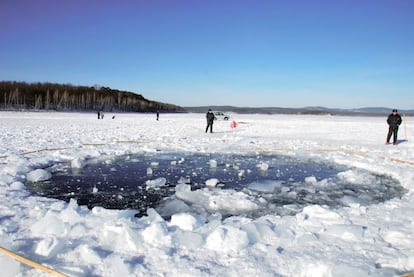Spanish-led study could help save Earth from meteorite impacts
Investigators believe results of analysis may help design future asteroid deflection missions
On Valentine’s Day 2013, astronomers around the world watched on as the 2012 DA14 asteroid, an object discovered by Spanish scientists, passed Earth at a safe distance of 27,680 kilometers. But that same night, another object around 20 meters in diameter closed in on our planet, unnoticed by anyone. Several hours later it became a spectacular ball of fire in the skies over Russia.

The meteorite exploded around 30 kilometers above ground and the shockwave injured hundreds, providing a stark warning of the threat posed to Earth by such objects.
We have to learn to deflect asteroids before it’s too late
Josep Maria Trigo, researcher
Now, a team of European scientists headed by Spanish investigators has been the first to analyze a fragment of the meteorite which scattered thousands of pieces of debris over the frozen plains of Chelyabinsk, west of the Ural Mountains.
The team studied the mechanical properties of the minerals forming the Chelyabinsk meteorite, looking at hardness, elasticity and fracture toughness, or the amount of stress an object with a crack, or other existing flaws, can tolerate.
The results, which have been accepted for publication in the prestigious Astrophysical Journal, could play a key role in designing future space missions aimed at deflecting more dangerous meteorites and stopping them crashing into Earth, the researchers said in a press conference.
Meteorites of between 30 and 50 meters like the one that flattened several square kilometers of Russian forest in the so-called Tunguska event of 1908 happen “on a timescale of centuries or thousands of years, but we can experience an impact like Chelyabinsk at any moment, and we don’t know when,” said study co-author Josep Maria Trigo, an investigator with the Barcelona-based Institute of Space Sciences (IEEE-CSIC).
Trigo acknowledged that when an asteroid remains undetected, as in the case of the Chelyabinsk meteorite, or if it is only detected a matter of days or hours beforehand, there is not much that people can do. But if the object is detected with a margin of months or years, it could be diverted by launching a so-called kinetic projectile, or a projectile that doesn’t contain a charge.
For such a strategy to work, it is important to have as much information as possible about the composition of the object and where exactly to strike it. Meteorites like Chelyabinsk have their origins in asteroids that have been travelling through the Solar System for long periods of time and have suffered collisions that have changed their consistency and composition.
Studies like the one carried out by Spanish investigators could serve “to identify which zones have suffered the least impacts, and to ensure that [after the impact from the projectile] the meteorite heads in the opposite direction,” Trigo said.

The European Space Agency (ESA) had planned to work with NASA on a joint Asteroid Impact Mission (AIM), but the ESA pulled its funding for the project, leaving work stalled. NASA now plans to continue alone with its part of the project, which involves launching an impact device against an asteroid.
But Trigo said the European side of the project was “not over” and that “various European countries want AIM to make a comeback.”
“We have to learn to deflect asteroids before it’s too late,” he said.
English version by George Mills.
Tu suscripción se está usando en otro dispositivo
¿Quieres añadir otro usuario a tu suscripción?
Si continúas leyendo en este dispositivo, no se podrá leer en el otro.
FlechaTu suscripción se está usando en otro dispositivo y solo puedes acceder a EL PAÍS desde un dispositivo a la vez.
Si quieres compartir tu cuenta, cambia tu suscripción a la modalidad Premium, así podrás añadir otro usuario. Cada uno accederá con su propia cuenta de email, lo que os permitirá personalizar vuestra experiencia en EL PAÍS.
¿Tienes una suscripción de empresa? Accede aquí para contratar más cuentas.
En el caso de no saber quién está usando tu cuenta, te recomendamos cambiar tu contraseña aquí.
Si decides continuar compartiendo tu cuenta, este mensaje se mostrará en tu dispositivo y en el de la otra persona que está usando tu cuenta de forma indefinida, afectando a tu experiencia de lectura. Puedes consultar aquí los términos y condiciones de la suscripción digital.
More information
Últimas noticias
Most viewed
- Reinhard Genzel, Nobel laureate in physics: ‘One-minute videos will never give you the truth’
- Oona Chaplin: ‘I told James Cameron that I was living in a treehouse and starting a permaculture project with a friend’
- Pablo Escobar’s hippos: A serious environmental problem, 40 years on
- Why we lost the habit of sleeping in two segments and how that changed our sense of time
- Chevy Chase, the beloved comedian who was a monster off camera: ‘Not everyone hated him, just the people who’ve worked with him’












































